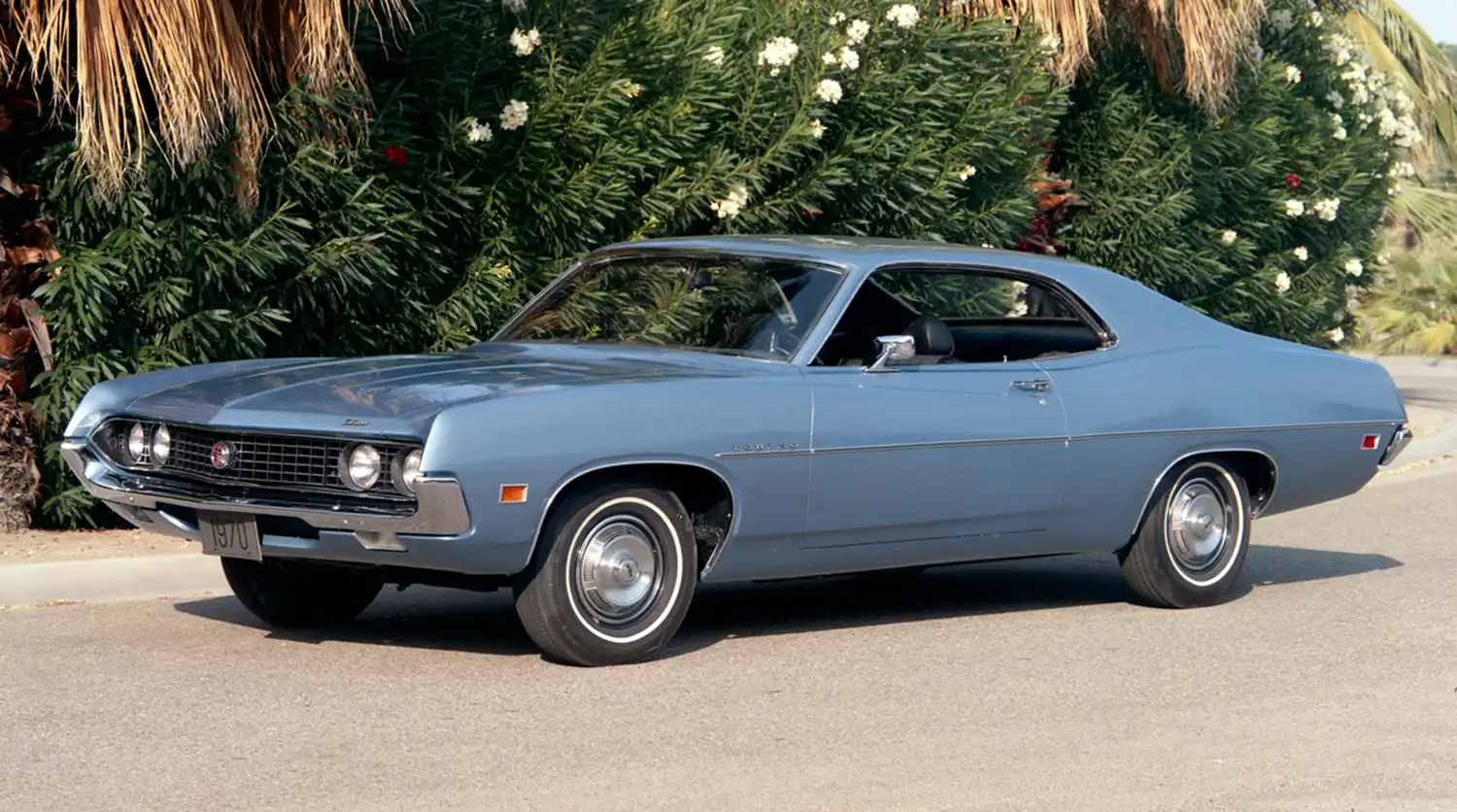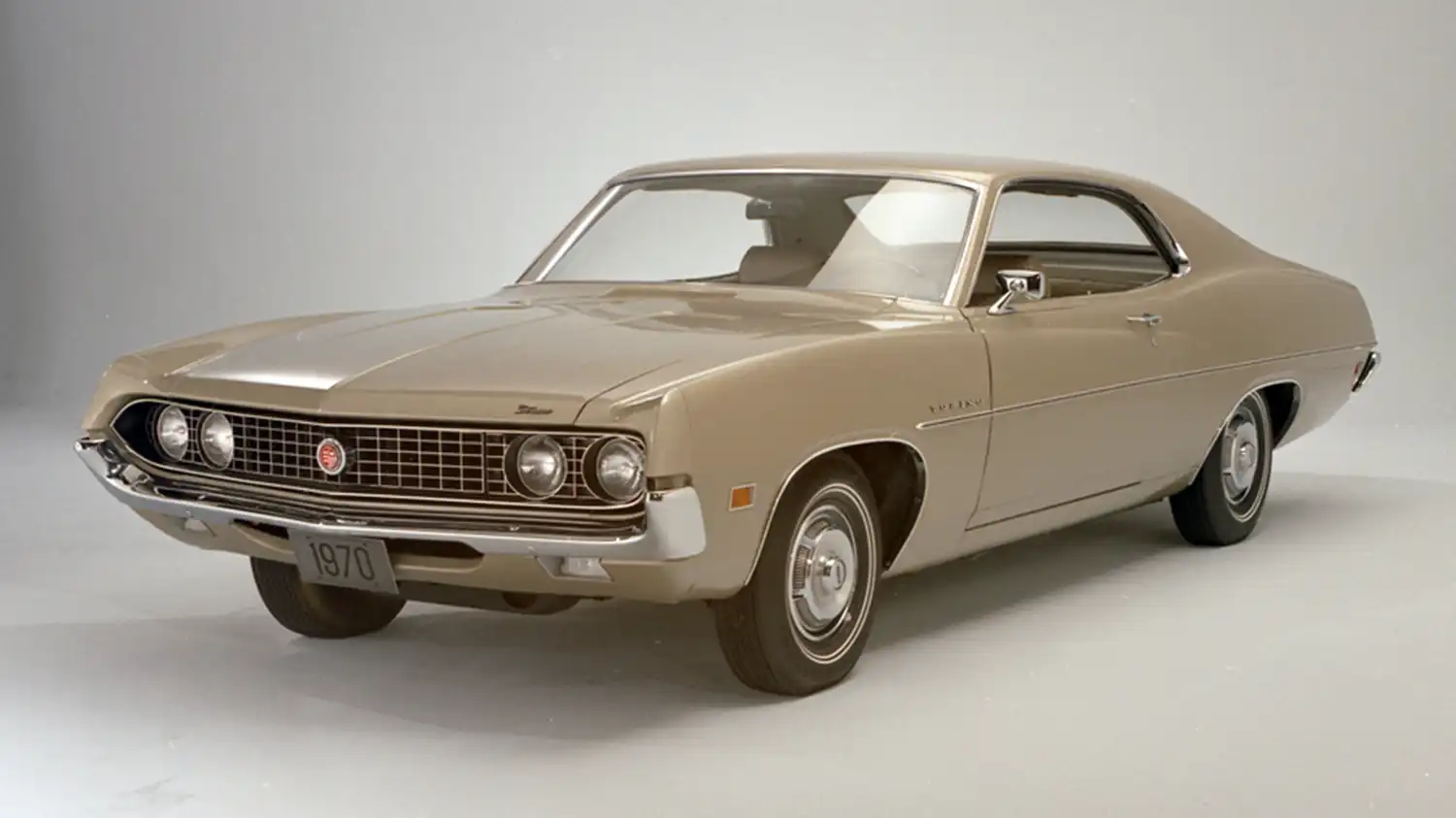
The 1970 Ford Torino was more than just another mid-size American car, it was Ford’s declaration of muscle car intent. Evolving from the Fairlane lineage, the Torino nameplate had debuted in 1968 as a more upscale alternative. By 1970, the Torino became Ford’s main intermediate model, and the two-door hardtop stood out as a blend of performance, style, and racing credibility. The 1970 Ford Torino carved its place in muscle car history with its distinctive design and formidable V8 lineup.
Sleek and Aerodynamic Styling
The 1970 Ford Torino two-door hardtop showcased styling that leaned toward aggression and aerodynamic efficiency. A long hood, short deck, and sculpted body lines gave it a muscular stance. On GT trims, concealed headlights flanked a wide grille, while the fastback roofline created a profile that hinted at speed. Horizontal taillights stretched across the rear, adding to its wide and purposeful appearance. Trim levels varied from the base Torino to the luxury-focused Brougham and the performance-oriented GT, each with distinct badges, trim pieces, and wheels.
Power and Performance of the 1970 Ford Torino
Engine choices ranged widely, starting from a modest inline-six for buyers focused on economy. But the real excitement came from Ford’s broad selection of V8s. Options included 302 and 351 cubic-inch engines, both Windsor and Cleveland variants, climbing all the way to the mighty 429 Cobra Jet and 429 Super Cobra Jet.
The 429 Cobra Jet, rated at 370 horsepower and 450 lb-ft of torque, was already a powerhouse. The Super Cobra Jet, paired with the Drag Pack option, delivered enhanced durability and drag-strip readiness. Despite similar horsepower figures, the Super Cobra Jet added a stronger bottom end, oil cooler, and shorter rear axle ratio for explosive launches.
With the 429-equipped Torino GT, acceleration was fierce. Tests at the time recorded 0–60 mph in the low six-second range and quarter-mile times in the mid-14s, firmly placing it among the top contenders in Detroit’s muscle car wars.
Transmission and Driving Experience
Buyers could tailor their Torino with several transmission options. A three-speed manual came standard, while a four-speed manual with a Hurst shifter brought added performance feel to big-block cars. For drivers preferring convenience, Ford’s SelectShift Cruise-O-Matic automatic delivered smooth shifts. The suspension, featuring independent front coil springs and a live rear axle, emphasized straight-line speed over sharp cornering, but upgrades such as power steering and heavy-duty suspension packages helped refine handling.
Interior Comfort and Features
Inside, the Torino balanced muscle with comfort. Bench seats were standard, but bucket seats with a center console were available for a sportier setup. The GT trim often included a tachometer and sportier instrumentation, while higher trims added options such as air conditioning, power windows, and upgraded sound systems. The Brougham trim leaned toward luxury, offering plush upholstery and more sound insulation.
NASCAR Success and Legacy
The Torino’s fastback design wasn’t just about looks, it was about winning races. The Torino Talladega and later Cobra models, derived from the same design language, became dominant forces in NASCAR. With their aerodynamic shapes and big 429 engines, Ford’s racing Torinos challenged Dodge and Plymouth on the superspeedways, cementing the model’s place in motorsport history.
Collectibility of the 1970 Ford Torino
Today, the 1970 Ford Torino, particularly in GT trim with Cobra Jet or Super Cobra Jet power, is considered a prized collectible. Its rarity compared to more common muscle cars like the Mustang or Camaro makes it even more desirable. Well-preserved or restored examples command strong values, especially those tied to Ford’s NASCAR heritage. For collectors, it represents a fusion of style, power, and racing pedigree that defined the muscle car era.
Summary
The 1970 Ford Torino two-door hardtop blended sleek styling with raw performance. It offered a wide range of engines, from base six-cylinders to the legendary 429 Cobra Jet V8s. Transmission options catered to both purists and comfort seekers, while trims ranged from practical to luxurious. Its aerodynamic design played a pivotal role in NASCAR dominance, and today, the Torino remains a muscle car classic valued by enthusiasts and collectors alike.
Disclaimer: Information regarding vintage automobiles can vary. Accuracy of specifications and production numbers is based on available historical data and may contain slight discrepancies.
Source: Ford Heritage Vault
